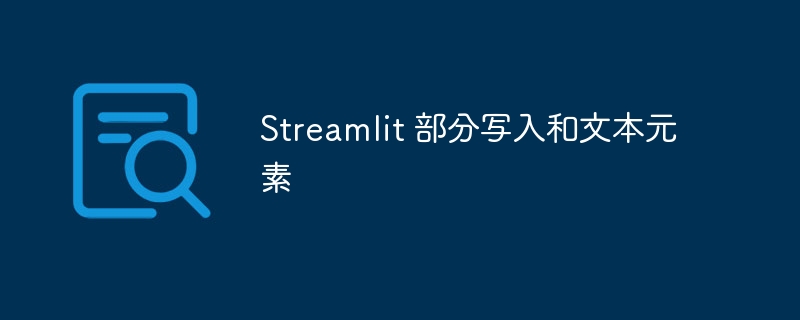Streamlit 部分写入和文本元素
来源:dev.to
时间:2024-11-25 09:39:42 463浏览 收藏
小伙伴们有没有觉得学习文章很有意思?有意思就对了!今天就给大家带来《Streamlit 部分写入和文本元素》,以下内容将会涉及到,若是在学习中对其中部分知识点有疑问,或许看了本文就能帮到你!

streamlit 入门:初学者指南
代码可以在这里找到:github - jamesbmour/blog_tutorials:
博客的视频版本可以在这里找到:https://youtu.be/eqcqnw7nw7m
介绍
streamlit 是一个开源应用程序框架,可让您以最少的努力创建美观的交互式 web 应用程序。如果您是数据科学家、机器学习工程师或任何处理数据的人,streamlit 是将您的 python 脚本快速转变为交互式应用程序的完美工具。在本教程中,我们将通过探索 streamlit 的一些强大功能(例如 st.write()、魔术命令和文本元素)来深入了解 streamlit 的基础知识。
让我们开始构建一个简单的应用程序来演示这些功能!
设置您的 streamlit 环境
在我们开始编写代码之前,请确保您已经安装了 streamlit。如果您尚未安装,可以使用以下命令进行安装:
pip install streamlit
现在,让我们开始编写我们的第一个 streamlit 应用程序。
构建您的第一个 streamlit 应用程序
1. 为您的应用程序添加标题
streamlit 使向您的应用添加标题和标题变得异常简单。 st.title() 函数允许您在应用程序顶部显示一个大标题,作为主标题。
import streamlit as st
st.title("introduction to streamlit: part 1")
这将在您的应用顶部显示一个大的、粗体的标题。
streamlit 写入元素
使用 st.write() 实现多功能输出
st.write() 函数是 streamlit 中最通用的函数之一。您可以使用它来显示几乎任何内容,包括文本、数据框、图表等,所有这些都只需一行代码。
显示数据框
让我们首先使用 st.write() 显示一个简单的 dataframe。
import pandas as pd
df = pd.dataframe({
"column 1": [1, 2, 3, 4],
"column 2": [10, 20, 30, 40]
})
st.write("dataframe using st.write() function")
st.write(df)
此代码创建一个包含两列的 dataframe 并将其直接显示在您的应用中。 st.write() 的美妙之处在于它会自动将 dataframe 格式化为一个整洁的表格,如果需要的话还可以添加滚动条。
显示 markdown 文本
st.write() 的另一个很酷的功能是它能够渲染 markdown 文本。这使您可以轻松添加格式化文本,例如标题、副标题和段落。
markdown_txt = (
"### this is a markdown header\\n"
"#### this is a markdown subheader\\n"
"this is a markdown paragraph.\\n"
)
st.write(markdown_txt)
只需几行代码,您就可以向您的应用添加富文本。
使用 st.write_stream() 流式传输数据
streamlit 还允许您使用 st.write_stream() 函数将数据实时流式传输到您的应用程序。这对于显示随时间更新的数据特别有用,例如传感器读数或实时分析。
import time
st.write("## streaming data using st.write_stream() function")
stream_btn = st.button("click button to stream data")
text = """
# stream a generator, iterable, or stream-like sequence to the app.
"""
def stream_data(txt="hello, world!"):
for word in txt.split(" "):
yield word + " "
time.sleep(0.01)
if stream_btn:
st.write_stream(stream_data(text))
在此示例中,单击按钮时,应用程序将开始从 text 字符串逐字流式传输数据,模拟实时数据更新。
streamlit文本元素
除了数据流之外,streamlit 还提供了多个文本元素来增强应用程序的呈现效果。
标题和副标题
您可以使用 st.header() 和 st.subheader() 轻松添加标题和子标题:
st.header("this is a header")
st.subheader("this is a subheader")
这些功能有助于构建您的内容,使您的应用更有条理、更具视觉吸引力。
字幕
标题对于添加小注释或解释很有用。您可以使用 st.caption() 添加它们:
st.caption("this is a caption")
显示代码
如果你想在应用程序中显示代码片段,可以使用 st.code():
code_txt = """
import pandas as pd
import streamlit as st
st.title("streamlit tutorials")
for i in range(10):
st.write(i)
"""
st.code(code_txt)
这将在格式良好、语法突出显示的块中显示代码。
显示数学表达式
对于那些需要包含数学方程的人,streamlit 支持 latex:
st.latex(r"e = mc^2") st.latex(r"\\int_a^b x^2 dx")
这些命令将直接在您的应用程序中渲染 latex 方程。
添加分隔线
要分隔应用程序的不同部分,您可以使用 st.divider():
st.write("This is some text below the divider.")
st.divider()
st.write("This is some other text below the divider.")
分隔线在各部分之间添加一条水平线,有助于在视觉上分解内容。
结论
在本介绍性教程中,我们介绍了 streamlit 的基础知识,包括如何使用 st.write() 显示数据和文本,以及如何使用 st.write_stream() 流式传输数据。我们还探索了各种文本元素,以增强应用程序的结构和可读性。
streamlit 使得只需几行代码即可轻松创建交互式 web 应用程序。无论您是构建仪表板、数据探索工具还是任何其他数据驱动的应用程序,streamlit 都能提供您快速入门所需的工具。
在下一个教程中,我们将深入研究 streamlit 中的小部件和交互功能。请继续关注!
如果您发现本教程有帮助,请不要忘记分享并订阅更多内容。下一篇文章见!
如果您想支持我的写作或请我喝杯啤酒:https://buymeacoffee.com/bmours
文中关于的知识介绍,希望对你的学习有所帮助!若是受益匪浅,那就动动鼠标收藏这篇《Streamlit 部分写入和文本元素》文章吧,也可关注golang学习网公众号了解相关技术文章。
-
501 收藏
-
501 收藏
-
501 收藏
-
501 收藏
-
501 收藏
-
106 收藏
-
151 收藏
-
104 收藏
-
138 收藏
-
464 收藏
-
111 收藏
-
489 收藏
-
136 收藏
-
152 收藏
-
251 收藏
-
324 收藏
-
143 收藏
-

- 前端进阶之JavaScript设计模式
- 设计模式是开发人员在软件开发过程中面临一般问题时的解决方案,代表了最佳的实践。本课程的主打内容包括JS常见设计模式以及具体应用场景,打造一站式知识长龙服务,适合有JS基础的同学学习。
- 立即学习 543次学习
-

- GO语言核心编程课程
- 本课程采用真实案例,全面具体可落地,从理论到实践,一步一步将GO核心编程技术、编程思想、底层实现融会贯通,使学习者贴近时代脉搏,做IT互联网时代的弄潮儿。
- 立即学习 516次学习
-

- 简单聊聊mysql8与网络通信
- 如有问题加微信:Le-studyg;在课程中,我们将首先介绍MySQL8的新特性,包括性能优化、安全增强、新数据类型等,帮助学生快速熟悉MySQL8的最新功能。接着,我们将深入解析MySQL的网络通信机制,包括协议、连接管理、数据传输等,让
- 立即学习 500次学习
-

- JavaScript正则表达式基础与实战
- 在任何一门编程语言中,正则表达式,都是一项重要的知识,它提供了高效的字符串匹配与捕获机制,可以极大的简化程序设计。
- 立即学习 487次学习
-

- 从零制作响应式网站—Grid布局
- 本系列教程将展示从零制作一个假想的网络科技公司官网,分为导航,轮播,关于我们,成功案例,服务流程,团队介绍,数据部分,公司动态,底部信息等内容区块。网站整体采用CSSGrid布局,支持响应式,有流畅过渡和展现动画。
- 立即学习 485次学习
